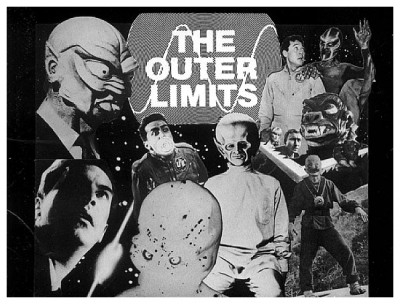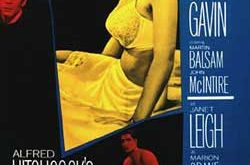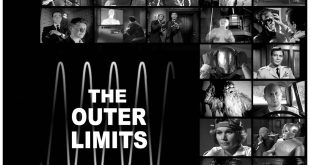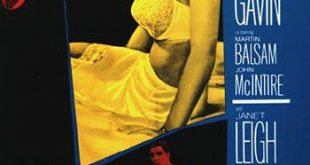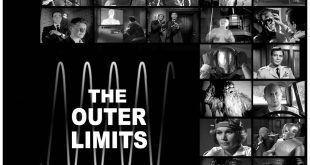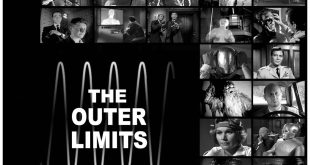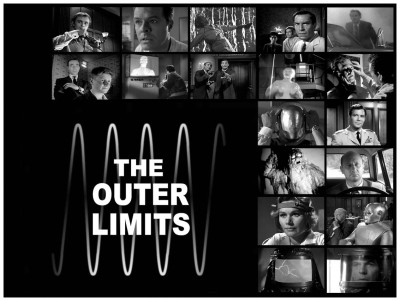 “There is nothing wrong with your television set. Do not attempt to adjust the picture. We are controlling transmission. We control the horizontal, we control the vertical. For the next hour, sit quietly and we will control what you see and hear. You are about to participate in a great adventure. You are about to experience the awe and mystery which reaches from the inner mind to…The Outer Limits.”
“There is nothing wrong with your television set. Do not attempt to adjust the picture. We are controlling transmission. We control the horizontal, we control the vertical. For the next hour, sit quietly and we will control what you see and hear. You are about to participate in a great adventure. You are about to experience the awe and mystery which reaches from the inner mind to…The Outer Limits.”
 #10 NIGHTMARE directed by John Erman from a script by Joseph Stefano. In response to an unprovoked nuclear attack from the planet Ebon, a group of soldiers representing Unified Earth is sent to fight the enemy on an alien world. Now captured, the soldiers undergo physical and psychological torture while interrogated by an Ebonite (John Anderson) who possess the ability to control the five senses. The prisoners become suspicious of each other when their captor claims to have obtained military secrets, which is further complicated by each soldier’s origins and the unexpected appearance of high-ranking human generals among the aliens. One soldier is blinded, another made mute, and all are subjected to various interactive illusions implanted in their minds, allowing them to feel a false sense of security or reveal hidden emotional conflicts. It’s eventually revealed that it’s all just a test organised by human generals to gauge the loyalty and valor of their troops under intense interrogation and psychological stress. The Earth-Ebon war itself is fake, and the Ebonites’ initial bombing was accidental. The aliens – a peaceful, honorable civilisation – insist that the immoral inhuman experiment ends, but not before failing to prevent one last human from being killed, one of the conspiring generals thought to be an illusion. Nightmare was one of John Erman’s earliest jobs as a director, and depicts captured Earth soldiers being tormented by aliens on a mostly barren set consisting of a few rock-like props and doorways. Its design bears many striking similarities to the third season Star Trek episode The Empath, also directed by Erman, in which Kirk, Spock and McCoy spend much of their time on a mostly bare set consisting of a few props and dark curtains, also being tormented by an alien force. The story may be easily dismissed due to the minimal sets, but it’s very well written, focusing on subjects that are still regarded important today, including imprisonment and torture of soldiers and the treatment of suspected terrorists. Clever writing and a nice twist makes this one worth seeing, not to mention a chance to see a young Martin Sheen in a rather emotionally-charged role, ably supported by actors Whit Bissell, Ed Nelson and James Shigeta.
#10 NIGHTMARE directed by John Erman from a script by Joseph Stefano. In response to an unprovoked nuclear attack from the planet Ebon, a group of soldiers representing Unified Earth is sent to fight the enemy on an alien world. Now captured, the soldiers undergo physical and psychological torture while interrogated by an Ebonite (John Anderson) who possess the ability to control the five senses. The prisoners become suspicious of each other when their captor claims to have obtained military secrets, which is further complicated by each soldier’s origins and the unexpected appearance of high-ranking human generals among the aliens. One soldier is blinded, another made mute, and all are subjected to various interactive illusions implanted in their minds, allowing them to feel a false sense of security or reveal hidden emotional conflicts. It’s eventually revealed that it’s all just a test organised by human generals to gauge the loyalty and valor of their troops under intense interrogation and psychological stress. The Earth-Ebon war itself is fake, and the Ebonites’ initial bombing was accidental. The aliens – a peaceful, honorable civilisation – insist that the immoral inhuman experiment ends, but not before failing to prevent one last human from being killed, one of the conspiring generals thought to be an illusion. Nightmare was one of John Erman’s earliest jobs as a director, and depicts captured Earth soldiers being tormented by aliens on a mostly barren set consisting of a few rock-like props and doorways. Its design bears many striking similarities to the third season Star Trek episode The Empath, also directed by Erman, in which Kirk, Spock and McCoy spend much of their time on a mostly bare set consisting of a few props and dark curtains, also being tormented by an alien force. The story may be easily dismissed due to the minimal sets, but it’s very well written, focusing on subjects that are still regarded important today, including imprisonment and torture of soldiers and the treatment of suspected terrorists. Clever writing and a nice twist makes this one worth seeing, not to mention a chance to see a young Martin Sheen in a rather emotionally-charged role, ably supported by actors Whit Bissell, Ed Nelson and James Shigeta.
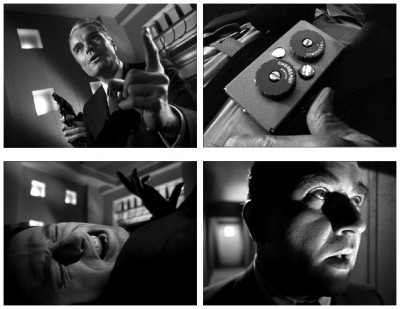 #11 IT CRAWLED OUT OF THE WOODWORK directed by Gerd Oswald from a script by Joseph Stefano. A cleaning lady (Lea Marmer) vacuums up what appears to be a clump of dust but, as soon as it’s in the vacuum cleaner, it explodes into a bizarre energy entity. Some time later, NORCO employee Stuart Peters (Michael Forest) and his brother Jory (Scott Marlowe) drive up to a security guard at the gates of the NORCO physics research centre. The guard slips them a matchbook on which he has scrawled, “Don’t come back. NORCO doomed,” and orders them to leave. As the brothers drive away, a monstrous explosion of energy appears and the frightened guard is disintegrated. The next day Stuart meets his boss Doctor Block (Kent Smith) and mentions the note, which Block dismisses. Block leaves Stuart in the laboratory with co-worker Stephanie Linden (Joan Camden), who directs Stuart into a dark corridor and locks him in, releasing the grotesque energy entity that kills him instantly. When Stuart does not return, his brother Jory grows worried and confides his concerns to his girlfriend Gaby (Barbara Luna). However, when Stuart does reappear, Jory notices a strange device strapped around his brother’s chest. Stuart stumbles backward into a bathtub and is electrocuted, proving that Stuart was wearing some sort of pacemaker. Police detective Siroleo (Ed Asner) confronts Block who feigns ignorance and denies the allegations. However, Linden reveals the truth: a being composed entirely of energy has been accidentally created, can consume anyone with a mere touch, and is so threatening that those who encounter it die instantly. Block has found a way to control the entity and keep it contained while he tries to study the monster. When the other scientists demanded its destruction, Block used the creature to frighten them to death, then bring them back to life with pacemakers. Jory arrives at the centre to uncover the truth about what happened to his brother and, with Linden and Siroleo, is held at gunpoint by Block, who releases the monster. Siroleo shoots Block and must confront the energy being. Since the creature needs energy to sustain itself, they resort to cutting all power to the centre, thus forcing the being to withdraw back into the chamber where it is contained. Unfortunately, this also causes Linden’s pacemaker to fail and, as things settle down, Jory and Siroleo turn to look with uncertainty towards the chamber where the monster has been contained, still powerful and alive. From a show known for its unique ‘monsters’, breathtaking cinematography, superb writing and talented actors comes a tale of a malevolent energised ball of fluff. Though it’s never explained how it happened, the story is one of the best of the first season. The dialogue between the detective and Linden is priceless and both actors delve into their respective roles with much skill. It’s no surprise that Ed Asner appeared in almost every major television show of the sixties leading up to his triumphs during the seventies as Lou Grant on both The Mary Tyler Moore Show and his own spin-off show. Still alive at this writing Asner, now 84 years old, has accumulated more than three hundred film and television credits.
#11 IT CRAWLED OUT OF THE WOODWORK directed by Gerd Oswald from a script by Joseph Stefano. A cleaning lady (Lea Marmer) vacuums up what appears to be a clump of dust but, as soon as it’s in the vacuum cleaner, it explodes into a bizarre energy entity. Some time later, NORCO employee Stuart Peters (Michael Forest) and his brother Jory (Scott Marlowe) drive up to a security guard at the gates of the NORCO physics research centre. The guard slips them a matchbook on which he has scrawled, “Don’t come back. NORCO doomed,” and orders them to leave. As the brothers drive away, a monstrous explosion of energy appears and the frightened guard is disintegrated. The next day Stuart meets his boss Doctor Block (Kent Smith) and mentions the note, which Block dismisses. Block leaves Stuart in the laboratory with co-worker Stephanie Linden (Joan Camden), who directs Stuart into a dark corridor and locks him in, releasing the grotesque energy entity that kills him instantly. When Stuart does not return, his brother Jory grows worried and confides his concerns to his girlfriend Gaby (Barbara Luna). However, when Stuart does reappear, Jory notices a strange device strapped around his brother’s chest. Stuart stumbles backward into a bathtub and is electrocuted, proving that Stuart was wearing some sort of pacemaker. Police detective Siroleo (Ed Asner) confronts Block who feigns ignorance and denies the allegations. However, Linden reveals the truth: a being composed entirely of energy has been accidentally created, can consume anyone with a mere touch, and is so threatening that those who encounter it die instantly. Block has found a way to control the entity and keep it contained while he tries to study the monster. When the other scientists demanded its destruction, Block used the creature to frighten them to death, then bring them back to life with pacemakers. Jory arrives at the centre to uncover the truth about what happened to his brother and, with Linden and Siroleo, is held at gunpoint by Block, who releases the monster. Siroleo shoots Block and must confront the energy being. Since the creature needs energy to sustain itself, they resort to cutting all power to the centre, thus forcing the being to withdraw back into the chamber where it is contained. Unfortunately, this also causes Linden’s pacemaker to fail and, as things settle down, Jory and Siroleo turn to look with uncertainty towards the chamber where the monster has been contained, still powerful and alive. From a show known for its unique ‘monsters’, breathtaking cinematography, superb writing and talented actors comes a tale of a malevolent energised ball of fluff. Though it’s never explained how it happened, the story is one of the best of the first season. The dialogue between the detective and Linden is priceless and both actors delve into their respective roles with much skill. It’s no surprise that Ed Asner appeared in almost every major television show of the sixties leading up to his triumphs during the seventies as Lou Grant on both The Mary Tyler Moore Show and his own spin-off show. Still alive at this writing Asner, now 84 years old, has accumulated more than three hundred film and television credits.
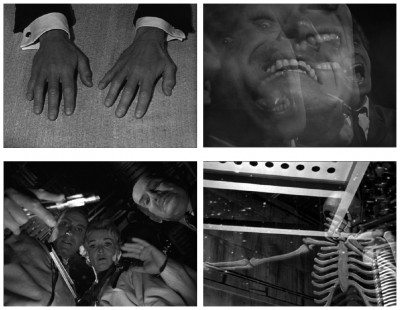 #12 THE BORDERLAND written and directed by Leslie Stevens. An eccentric millionaire named Hartley (Barry Jones) has engaged psychic Mrs. Palmer (Gladys Cooper) to contact his dead son, but scientist Ian Fraser (Mark Richman) and his wife Eva (Nina Foch) expose Palmer as a fraud, and she is thrown out of Hartley’s home. Hartley is grateful to the scientists, and wishes to fund Fraser’s research into other planes of existence at Arrex Electronics. Fraser insists that he has developed a method that can pierce what he calls the ‘borderland’ which may be the afterlife, but he needs the energy of a metropolitan power grid to do so. Hartley agrees to arrange it only if Fraser will attempt to contact his dead son. Fraser agrees and the experiment begins, sending inanimate objects such as inert elements shaped into cubes, as well as flowers and lab rats, into the other dimension. Just as Fraser himself successfully enters the fourth dimensional limbo world, Mrs. Palmer sabotages the power supply and the dimensional overlap begins to collapse. At the last moment Fraser is pulled free of the magnetic field generating the inter-dimensional doorway but, desperate to contact his dead son, Hartley walks into the magnetic coil chamber and instantly disappears to places unknown. Many episodes of The Outer Limits were designed to scare audiences, but The Borderland had an entirely different effect. With its jargon-filled dialogue about magnetic fields, electrical power, antimatter, and its many stock-footage shots of apparatus in a massive power plant and stunning visual effects, it left audiences awestruck and succeeded in inspiring a profound curiosity about electricity, magnetism, matter and energy. Whoever said watching television dulls the mind never saw The Outer Limits.
#12 THE BORDERLAND written and directed by Leslie Stevens. An eccentric millionaire named Hartley (Barry Jones) has engaged psychic Mrs. Palmer (Gladys Cooper) to contact his dead son, but scientist Ian Fraser (Mark Richman) and his wife Eva (Nina Foch) expose Palmer as a fraud, and she is thrown out of Hartley’s home. Hartley is grateful to the scientists, and wishes to fund Fraser’s research into other planes of existence at Arrex Electronics. Fraser insists that he has developed a method that can pierce what he calls the ‘borderland’ which may be the afterlife, but he needs the energy of a metropolitan power grid to do so. Hartley agrees to arrange it only if Fraser will attempt to contact his dead son. Fraser agrees and the experiment begins, sending inanimate objects such as inert elements shaped into cubes, as well as flowers and lab rats, into the other dimension. Just as Fraser himself successfully enters the fourth dimensional limbo world, Mrs. Palmer sabotages the power supply and the dimensional overlap begins to collapse. At the last moment Fraser is pulled free of the magnetic field generating the inter-dimensional doorway but, desperate to contact his dead son, Hartley walks into the magnetic coil chamber and instantly disappears to places unknown. Many episodes of The Outer Limits were designed to scare audiences, but The Borderland had an entirely different effect. With its jargon-filled dialogue about magnetic fields, electrical power, antimatter, and its many stock-footage shots of apparatus in a massive power plant and stunning visual effects, it left audiences awestruck and succeeded in inspiring a profound curiosity about electricity, magnetism, matter and energy. Whoever said watching television dulls the mind never saw The Outer Limits.
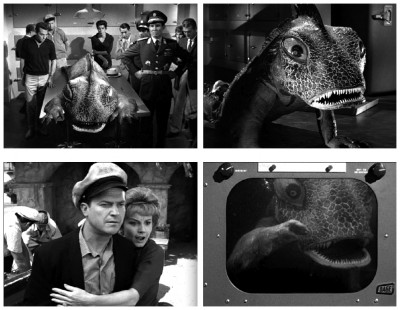 #12 TOURIST ATTRACTION directed by László Benedek from a script by Dean Riesner. Dominating millionaire John Dexter (Ralph Meeker) leads a group of explorers and scientists pursuing an ancient lake monster reputed to live in the waters of a South American dictatorship called San Blas. Using underwater detection equipment, the creature is spotted swimming along the lakebed. After several attempts the creature is eventually captured and taken to the local university for study. Once the creature is immobilised and stored inside a freezer, Dexter decides to transport it to the United States to place it on display in order to enhance his own reputation. The ruler of San Blas, Juan Mercurio (Henry Silva), plans to use it to attract tourists to his country’s faltering World’s Fair, claiming the animal as a national treasure. While all this is going on, the creature returns to life and emits ultrasonic waves causing the freezer door to implode. It’s recaptured before it can escape, and an armed guard from Mercurio’s palace is ordered to stand watch. Dexter overpowers the guard and arranges for the creature’s transport back to the United States. While his assistants prepare the monster for its trip, they are shocked to see several more of the creatures emerging from the lake. A marine biologist (Jay Novello) urges them to turn the creature loose and, reluctantly, they comply and watch as it joins its comrades. Dexter shoots at the creatures in an effort to stop them, and is halted by a piercing ultrasonic pulse. The creatures crawl back into the lake and disappear below the surface. With the combined energy of their earth-shattering sound waves, the creatures gather and then topple the dam created by Mercurio during his reign of power, killing him and flooding San Blas, destroying all that he had built. Perhaps the most ambitious yet least effective Outer Limits story is Tourist Attraction, one of the few episodes to use voiceover narration at the beginning of each act. The script and plot is handled rather clumsily with a fake-looking monster, even by Outer Limits standards. Several character subplots compete for attention with Henry Silva’s role of a power-hungry dictator becoming a casualty. The script represents an ambitious attempt at a more modernistic post-conservative Cold War narrative – it is commendable in its effort – but both budget and time restrictions sabotage the respectable underlying premise.
#12 TOURIST ATTRACTION directed by László Benedek from a script by Dean Riesner. Dominating millionaire John Dexter (Ralph Meeker) leads a group of explorers and scientists pursuing an ancient lake monster reputed to live in the waters of a South American dictatorship called San Blas. Using underwater detection equipment, the creature is spotted swimming along the lakebed. After several attempts the creature is eventually captured and taken to the local university for study. Once the creature is immobilised and stored inside a freezer, Dexter decides to transport it to the United States to place it on display in order to enhance his own reputation. The ruler of San Blas, Juan Mercurio (Henry Silva), plans to use it to attract tourists to his country’s faltering World’s Fair, claiming the animal as a national treasure. While all this is going on, the creature returns to life and emits ultrasonic waves causing the freezer door to implode. It’s recaptured before it can escape, and an armed guard from Mercurio’s palace is ordered to stand watch. Dexter overpowers the guard and arranges for the creature’s transport back to the United States. While his assistants prepare the monster for its trip, they are shocked to see several more of the creatures emerging from the lake. A marine biologist (Jay Novello) urges them to turn the creature loose and, reluctantly, they comply and watch as it joins its comrades. Dexter shoots at the creatures in an effort to stop them, and is halted by a piercing ultrasonic pulse. The creatures crawl back into the lake and disappear below the surface. With the combined energy of their earth-shattering sound waves, the creatures gather and then topple the dam created by Mercurio during his reign of power, killing him and flooding San Blas, destroying all that he had built. Perhaps the most ambitious yet least effective Outer Limits story is Tourist Attraction, one of the few episodes to use voiceover narration at the beginning of each act. The script and plot is handled rather clumsily with a fake-looking monster, even by Outer Limits standards. Several character subplots compete for attention with Henry Silva’s role of a power-hungry dictator becoming a casualty. The script represents an ambitious attempt at a more modernistic post-conservative Cold War narrative – it is commendable in its effort – but both budget and time restrictions sabotage the respectable underlying premise.
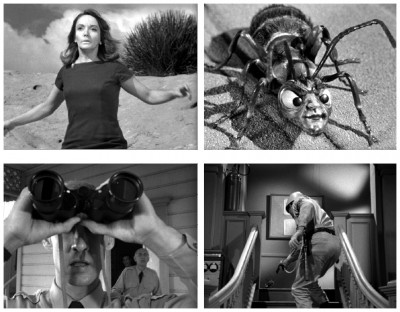 #14 THE ZANTI MISFITS directed by Leonard Horn from a script by John M. Nickolaus. Military forces have cordoned off a ghost town in a Californian desert while awaiting the arrival of a spacecraft from the planet Zanti. Historian Professor Steve Grave (Michael Tolan) and stone-faced Major Hill (Claude Woolman) hope the top-secret landing will be peaceful, but the Zanti are not giving Earthlings any choice in the matter. After making radio contact with the United States government, the rulers of Zanti have decided that Earth would be the perfect place to send their criminals, and threaten total destruction if the penal ship is attacked. General Hart (Robert F. Simon) assures the Zanti they may land, but the aliens suspect trouble. “Do not betray us,” they warn. Meanwhile, bank robber Ben Garth (Bruce Dern) and his morally-deficient girlfriend Lisa (Olive Deering) cross the cordon and run over a soldier. The Zanti spaceship descends and Ben investigates the landing site, triggering a jailbreak of insectoid Zanti misfits.
#14 THE ZANTI MISFITS directed by Leonard Horn from a script by John M. Nickolaus. Military forces have cordoned off a ghost town in a Californian desert while awaiting the arrival of a spacecraft from the planet Zanti. Historian Professor Steve Grave (Michael Tolan) and stone-faced Major Hill (Claude Woolman) hope the top-secret landing will be peaceful, but the Zanti are not giving Earthlings any choice in the matter. After making radio contact with the United States government, the rulers of Zanti have decided that Earth would be the perfect place to send their criminals, and threaten total destruction if the penal ship is attacked. General Hart (Robert F. Simon) assures the Zanti they may land, but the aliens suspect trouble. “Do not betray us,” they warn. Meanwhile, bank robber Ben Garth (Bruce Dern) and his morally-deficient girlfriend Lisa (Olive Deering) cross the cordon and run over a soldier. The Zanti spaceship descends and Ben investigates the landing site, triggering a jailbreak of insectoid Zanti misfits.
 After killing Ben, one of the Zantis chases the now-terrified Lisa towards the military outpost, while the rest of the aliens pilot their spaceship to land on the roof of the outpost. When the Zanti prisoners attack Earth’s nervous soldiers, a brutal firefight ensues until the alien invaders are wiped out. The soldiers anxiously await the expected reprisals but instead they receive a message of thanks from the Zanti leader who explains that they are incapable of executing their own species, so they sent them into the hands of practiced executioners: the human race. Imaginatively directed by Leonard Horn and intelligently written by producer Joseph Stefano, The Zanti Misfits features an atmospheric soundtrack and one of the most memorable aliens ever seen on television. Although animated by stop-motion maestro Jim Danforth, there were practical effects employed as well. For instance, when the Zantis attack after landing on the roof of the command post, the creatures are seen descending an exterior wall, mere models on wires.
After killing Ben, one of the Zantis chases the now-terrified Lisa towards the military outpost, while the rest of the aliens pilot their spaceship to land on the roof of the outpost. When the Zanti prisoners attack Earth’s nervous soldiers, a brutal firefight ensues until the alien invaders are wiped out. The soldiers anxiously await the expected reprisals but instead they receive a message of thanks from the Zanti leader who explains that they are incapable of executing their own species, so they sent them into the hands of practiced executioners: the human race. Imaginatively directed by Leonard Horn and intelligently written by producer Joseph Stefano, The Zanti Misfits features an atmospheric soundtrack and one of the most memorable aliens ever seen on television. Although animated by stop-motion maestro Jim Danforth, there were practical effects employed as well. For instance, when the Zantis attack after landing on the roof of the command post, the creatures are seen descending an exterior wall, mere models on wires.
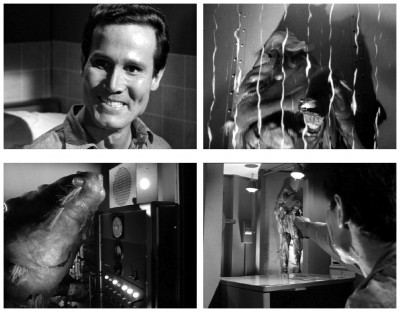 #15 THE MICE directed by Alan Crosland Junior from a script by Bill Ballinger, Lou Morheim and Joseph Stefano. An advanced civilisation contacts the United States to test an experimental teleportation system by exchanging citizens. Fearing the matter transport will fail, the military want to send a prisoner serving a life sentence and don’t care if a murderer is set loose on Chromos, because it’s ten light years away. A convict named Chino Rivera (Henry Silva), sentenced to life imprisonment after being charged with first degree homicide when he killed his sister’s abusive husband, volunteers for the matter transportation experiment. When the Chromo ‘volunteer’ (Hugh Langtry) materialises in the testing lab, it creates havoc until it is finally subdued, and eventually allowed to freely explore the countryside surrounding the research facility. Problems ensue as researchers begin to die and Rivera is blamed, only to find out that the Chromoite has actually been sent to Earth to experiment with ways of producing artificial food for his starving race. The aliens had informed the Earth scientists that their species sustained themselves through photosynthesis, but the doctor assigned to monitor Rivera witnesses the alien eating an unknown substance that it had chemically germinated in a pond near the research facility. The military capture the alien ‘volunteer’ and the project leader re-establishes communication with the Chromo scientists to admonish their actions, but the Chromos readily admit their deception, explaining that their ‘volunteer’ is actually one of their scientists looking for a way to feed the millions of inhabitants on Chromo. The aliens believed that we would not have aided in their plight, to which the project leader calmly replies, “You could have asked. All you had to do was ask.” Like many of the lesser Outer Limits episodes, this one rambles a bit and the action-filled second half is more confusing than suspenseful, but there are two things that make it memorable. One is Henry Silva’s portrayal of the convict Rivera, who proves to be a far more fascinating and likable character than one might expect. The other is the alien Chromoite, which looks like something you’d get if you blew your nose too hard. Although the alien is not terribly frightening, it certainly looks quite disgusting. Keep an eye out (ow!) near the end of the episode for a young Dabney Coleman, who appeared in several Outer Limits stories, more than a decade before finding fame as the preacher in Mary Hartman Mary Hartman. Growing that moustache must be the best career move he ever made.
#15 THE MICE directed by Alan Crosland Junior from a script by Bill Ballinger, Lou Morheim and Joseph Stefano. An advanced civilisation contacts the United States to test an experimental teleportation system by exchanging citizens. Fearing the matter transport will fail, the military want to send a prisoner serving a life sentence and don’t care if a murderer is set loose on Chromos, because it’s ten light years away. A convict named Chino Rivera (Henry Silva), sentenced to life imprisonment after being charged with first degree homicide when he killed his sister’s abusive husband, volunteers for the matter transportation experiment. When the Chromo ‘volunteer’ (Hugh Langtry) materialises in the testing lab, it creates havoc until it is finally subdued, and eventually allowed to freely explore the countryside surrounding the research facility. Problems ensue as researchers begin to die and Rivera is blamed, only to find out that the Chromoite has actually been sent to Earth to experiment with ways of producing artificial food for his starving race. The aliens had informed the Earth scientists that their species sustained themselves through photosynthesis, but the doctor assigned to monitor Rivera witnesses the alien eating an unknown substance that it had chemically germinated in a pond near the research facility. The military capture the alien ‘volunteer’ and the project leader re-establishes communication with the Chromo scientists to admonish their actions, but the Chromos readily admit their deception, explaining that their ‘volunteer’ is actually one of their scientists looking for a way to feed the millions of inhabitants on Chromo. The aliens believed that we would not have aided in their plight, to which the project leader calmly replies, “You could have asked. All you had to do was ask.” Like many of the lesser Outer Limits episodes, this one rambles a bit and the action-filled second half is more confusing than suspenseful, but there are two things that make it memorable. One is Henry Silva’s portrayal of the convict Rivera, who proves to be a far more fascinating and likable character than one might expect. The other is the alien Chromoite, which looks like something you’d get if you blew your nose too hard. Although the alien is not terribly frightening, it certainly looks quite disgusting. Keep an eye out (ow!) near the end of the episode for a young Dabney Coleman, who appeared in several Outer Limits stories, more than a decade before finding fame as the preacher in Mary Hartman Mary Hartman. Growing that moustache must be the best career move he ever made.
 #16 CONTROLLED EXPERIMENT written and directed by Leslie Stevens. Phobos (Barry Morse) and Deimos (Carroll O’Connor) are two Martians who wish to understand the human phenomena known as murder. The duo inconspicuously investigate a shooting that is about to take place in a downtown hotel lobby that resulted from a love triangle, predicted and then reported by Martian Central Control. Using a machine that can manipulate the flow of time like a recording, they review this same event over and over again. The Martians watch but are dumbfounded so they decide to rewind the scene but still draw a blank. Then they run it in slow motion, backward, forward, upside-down, inside-out and freeze the action in order to conduct tests such as blood pressure and temperature. They take the scene further back in time and follow the man to find out where he was coming from upstairs – a sexy brunette is up there. Still nothing. Phobos is no longer able to simply remain a passive observer and gives in to the temptation to tamper with the scenario to alter the outcome. They decide to redirect the bullet trajectory to see what result that produces but, according to Martian Central Control, what they have done will alter future events causing a temporal paradox that would eventually destroy the entire universe and the space-time continuum. Considering that television was still in its teens in 1963, this Outer Limits story is quite good. It’s also interesting to see Carroll O’Connor in action prior to gaining fame as Archie Bunker in All In The Family, and Barry Morse before starring in The Fugitive and Space:1999, not to mention a young Grace Lee Whitney before appearing as Yeoman Janice Rand in Star Trek. According to Morse, Controlled Experiment was intended to be a possible pilot for a forthcoming comedy series which, after being rejected, was broadcast as an Outer Limits episode instead, becoming the only comedy episode in the entire series. This episode makes considerable use of repeated footage as the alien observers view events several times over the same footage is played forward and backward. This meant that less original footage than usual needed to be shot for the episode, thus reducing its budget. The Martian equipment may look like something bought at a toy store and the plot may be silly, but it’s still an enjoyable episode.
#16 CONTROLLED EXPERIMENT written and directed by Leslie Stevens. Phobos (Barry Morse) and Deimos (Carroll O’Connor) are two Martians who wish to understand the human phenomena known as murder. The duo inconspicuously investigate a shooting that is about to take place in a downtown hotel lobby that resulted from a love triangle, predicted and then reported by Martian Central Control. Using a machine that can manipulate the flow of time like a recording, they review this same event over and over again. The Martians watch but are dumbfounded so they decide to rewind the scene but still draw a blank. Then they run it in slow motion, backward, forward, upside-down, inside-out and freeze the action in order to conduct tests such as blood pressure and temperature. They take the scene further back in time and follow the man to find out where he was coming from upstairs – a sexy brunette is up there. Still nothing. Phobos is no longer able to simply remain a passive observer and gives in to the temptation to tamper with the scenario to alter the outcome. They decide to redirect the bullet trajectory to see what result that produces but, according to Martian Central Control, what they have done will alter future events causing a temporal paradox that would eventually destroy the entire universe and the space-time continuum. Considering that television was still in its teens in 1963, this Outer Limits story is quite good. It’s also interesting to see Carroll O’Connor in action prior to gaining fame as Archie Bunker in All In The Family, and Barry Morse before starring in The Fugitive and Space:1999, not to mention a young Grace Lee Whitney before appearing as Yeoman Janice Rand in Star Trek. According to Morse, Controlled Experiment was intended to be a possible pilot for a forthcoming comedy series which, after being rejected, was broadcast as an Outer Limits episode instead, becoming the only comedy episode in the entire series. This episode makes considerable use of repeated footage as the alien observers view events several times over the same footage is played forward and backward. This meant that less original footage than usual needed to be shot for the episode, thus reducing its budget. The Martian equipment may look like something bought at a toy store and the plot may be silly, but it’s still an enjoyable episode.
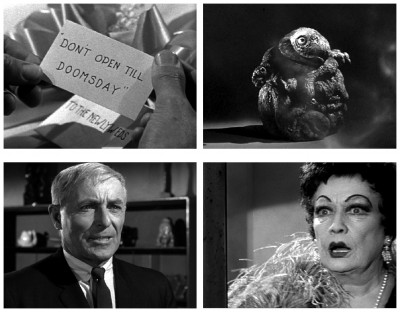 #17 DON’T OPEN TILL DOOMSDAY directed by Gerd Oswald from a script by Joseph Stefano. In the 1920s, a tiny space creature bent on destruction is captured by a scientist named Spazman (Anthony Jochim). His rival, Professor Kry, convinces the media that Spazman’s claims are bogus. The vengeful Spazman boxes up the invader’s miniature spacecraft as a wedding gift to Kry’s son. Unbeknownst to his bride, the bridegroom unwraps the box and is zapped by a beam of light emanating from the object, trapping him inside the box with the alien. Fast-forward three decades later, an eloping couple looking for a honeymoon spot, arrive at the now-derelict house owned by Mrs. Kry (Miriam Hopkins), an eccentric old woman who turns out to be the aforesaid bride driven to insanity by her husband’s disappearance. After the young bride (Melinda Plowman) disappears inside the box, it is revealed that Mrs. Kry has been luring young couples to her house, hoping to ‘trade’ them for her long-lost bridegroom with the alien intelligence inside the box. Later, the young bride’s father (John Hoyt) arrives to take his daughter back and is also abducted by the alien, finding himself inside the box, which is actually a ‘pocket dimension’ occupied by an amorphous one-eyed blob creature from an anti-matter universe. The father, his daughter and the still-young Mr. Kry are in there as well. The creature promises to free them all on the condition that they help him achieve his goal: reuniting with his eight other companions, each carrying an essential element which, when joined together, would result in the annihilation of our universe. Facing refusal, the enraged alien resorts to self-destruction after setting the daughter free, thus ‘uncreating’ himself and obliterating the entire mansion, with the young couple narrowly escaping. At times silly, illogical and over-the-top, this is nevertheless a memorable episode for The Outer Limits and for science fiction aficionados in general. All the actors give credible performances, including John Hoyt before playing the Enterprise’s first medical officer in Star Trek and the father of Flesh Gordon (1974). But the real star of Don’t Open Till Doomsday is the spirited Miriam Hopkins who plays crazy Mrs. Kry in a performance reminiscent of Bette Davis as Baby Jane Hudson in Whatever Happened To Baby Jane? (1962). Running the emotional gamut of a character who is angry, desperate, cunning, pathetic and downright evil, Hopkin’s plight is accentuated by effective mood-appropriate studio lighting that takes full advantage of the black and white film stock.
#17 DON’T OPEN TILL DOOMSDAY directed by Gerd Oswald from a script by Joseph Stefano. In the 1920s, a tiny space creature bent on destruction is captured by a scientist named Spazman (Anthony Jochim). His rival, Professor Kry, convinces the media that Spazman’s claims are bogus. The vengeful Spazman boxes up the invader’s miniature spacecraft as a wedding gift to Kry’s son. Unbeknownst to his bride, the bridegroom unwraps the box and is zapped by a beam of light emanating from the object, trapping him inside the box with the alien. Fast-forward three decades later, an eloping couple looking for a honeymoon spot, arrive at the now-derelict house owned by Mrs. Kry (Miriam Hopkins), an eccentric old woman who turns out to be the aforesaid bride driven to insanity by her husband’s disappearance. After the young bride (Melinda Plowman) disappears inside the box, it is revealed that Mrs. Kry has been luring young couples to her house, hoping to ‘trade’ them for her long-lost bridegroom with the alien intelligence inside the box. Later, the young bride’s father (John Hoyt) arrives to take his daughter back and is also abducted by the alien, finding himself inside the box, which is actually a ‘pocket dimension’ occupied by an amorphous one-eyed blob creature from an anti-matter universe. The father, his daughter and the still-young Mr. Kry are in there as well. The creature promises to free them all on the condition that they help him achieve his goal: reuniting with his eight other companions, each carrying an essential element which, when joined together, would result in the annihilation of our universe. Facing refusal, the enraged alien resorts to self-destruction after setting the daughter free, thus ‘uncreating’ himself and obliterating the entire mansion, with the young couple narrowly escaping. At times silly, illogical and over-the-top, this is nevertheless a memorable episode for The Outer Limits and for science fiction aficionados in general. All the actors give credible performances, including John Hoyt before playing the Enterprise’s first medical officer in Star Trek and the father of Flesh Gordon (1974). But the real star of Don’t Open Till Doomsday is the spirited Miriam Hopkins who plays crazy Mrs. Kry in a performance reminiscent of Bette Davis as Baby Jane Hudson in Whatever Happened To Baby Jane? (1962). Running the emotional gamut of a character who is angry, desperate, cunning, pathetic and downright evil, Hopkin’s plight is accentuated by effective mood-appropriate studio lighting that takes full advantage of the black and white film stock.
 #18 ZZZZZ directed by John Brahm from a script by Meyer Dolinsky. Ben Fields (Philip Abbott) is an entomologist developing a machine that can communicate with bees, and is seeking a lab assistant. Regina (Joanna Frank) is a giant mutant queen bee in human form, who is searching for a human mate to evolve her species. Regina is hired and accepted into their household. Suspicious of her background, Francesca Fields (Marsha Hunt) discovers Regina has lied, and witnesses her morphing into a giant bee while drawing nectar from a flower in their garden. Due to the metabolic changes while in human form, Regina experiences spasms of pain and is examined by a doctor, who tells Ben and Francesca that Regina may not be who she appears to be. Later, Francesca confronts Regina about her attempts to seduce Ben, whereupon Regina unleashes her army of drones kept in the laboratory, stinging Francesca to death. Ben, grief-stricken, accuses Regina of murdering his wife and causes her to topple off a second-storey balcony and fall to the ground below. She miraculously recovers, transforms into the queen bee and flies away.
#18 ZZZZZ directed by John Brahm from a script by Meyer Dolinsky. Ben Fields (Philip Abbott) is an entomologist developing a machine that can communicate with bees, and is seeking a lab assistant. Regina (Joanna Frank) is a giant mutant queen bee in human form, who is searching for a human mate to evolve her species. Regina is hired and accepted into their household. Suspicious of her background, Francesca Fields (Marsha Hunt) discovers Regina has lied, and witnesses her morphing into a giant bee while drawing nectar from a flower in their garden. Due to the metabolic changes while in human form, Regina experiences spasms of pain and is examined by a doctor, who tells Ben and Francesca that Regina may not be who she appears to be. Later, Francesca confronts Regina about her attempts to seduce Ben, whereupon Regina unleashes her army of drones kept in the laboratory, stinging Francesca to death. Ben, grief-stricken, accuses Regina of murdering his wife and causes her to topple off a second-storey balcony and fall to the ground below. She miraculously recovers, transforms into the queen bee and flies away.
 ZZZZZ was filmed entirely on a massive interior set, including the two-storey mockup of the house and garden constructed by Jack Poplin and his team on a single soundstage. The stunningly beautiful Joanna Frank gives a wonderful performance as queen bee Regina. She definitely gives one the impression that her character is trying to ‘blend in’ without understanding the nuances of human interaction. Some sources say that Joanna Frank was only nineteen years old when she was in this episode, but her birthdate is listed as 1941 so, unless they filmed this episode in 1960 and waited until 1964 to broadcast it, she couldn’t possibly have been nineteen.
ZZZZZ was filmed entirely on a massive interior set, including the two-storey mockup of the house and garden constructed by Jack Poplin and his team on a single soundstage. The stunningly beautiful Joanna Frank gives a wonderful performance as queen bee Regina. She definitely gives one the impression that her character is trying to ‘blend in’ without understanding the nuances of human interaction. Some sources say that Joanna Frank was only nineteen years old when she was in this episode, but her birthdate is listed as 1941 so, unless they filmed this episode in 1960 and waited until 1964 to broadcast it, she couldn’t possibly have been nineteen.
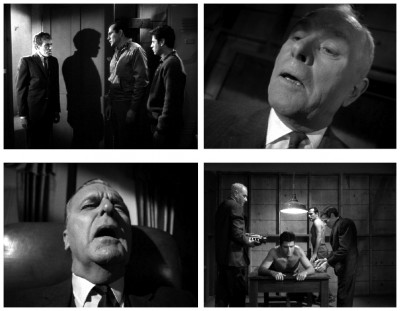 #19 THE INVISIBLES directed by Gerd Oswald from a script by Joseph Stefano. Three outcasts of society – Plannetta (Tony Mordente), Spain (Don Gordon) and Castle (Chris Warfield) – are taken to a compound that serves as the headquarters of a subversive secret society known only as the Invisibles. During debriefing, Spain immediately recognises the man speaking to them as a state governor (John Graham), but the ‘governor’ denies this, saying that his only role is that of an Invisible. They intend to infect government officials with crab-like parasites that attach themselves to people’s spines and take over their minds. By doing so, the Invisibles plan to conquer the world. Each new recruit will be given a target to infect following his inoculation, but Castle’s inoculation is unsuccessful and he becomes physically deformed, just like the servant (Walter Burke) at the compound. It’s revealed that Spain is actually a government agent sent to infiltrate the Invisibles. He sneaks out to meet his contact Johnny (William O. Douglas) in the woods and states his plan to become friends with the desperately lonely Plannetta. Unfortunately, Spain’s plan hits a snag when Johnny is killed and brought in as a corpse for trainees to practice on. Spain is assigned to infect General Hillary Clarke (Neil Hamilton) in Washington, but the reality is that the Invisibles are onto him – Clarke is already infected, and Spain was sent there so that Clarke could infect him when his inoculation wears off. Spain escapes when Clarke says too much and is momentarily tortured by his Invisible. Just as Spain flees the house, Clarke’s wife (Dee Hartford) accidentally hits him with the car, breaking his ankle, and he blacks out from pain. When he comes to, Mrs. Clarke tends to his injury, but he limps away and steals the car. Spain manages to find Plannetta, only to meet another twist of fate – he was Plannetta’s target all along. Weeping because he thinks Spain has betrayed him, Plannetta sets an Invisible on the ground, which begins to crawl toward Spain. The Invisible doesn’t move very quickly, but neither does Spain in his condition. Just in the nick of time, government agents arrive to shoot both the creature and Plannetta, thus saving Spain’s life. This is one of the best stories of the entire series, in fact it might have even made a great pilot episode for its own series. It’s a like a combination of Invasion Of The Body Snatchers by Jack Finney and The Puppet Masters by Robert Heinlein, expertly executed and compelling throughout. It’s also scary without requiring elaborate special effects or monsters. Neil Hamilton, who plays General Clarke, is best known for his role as Commissioner Gordon in the sixties Batman series, and can be spotted again in the next episode of The Outer Limits, The Bellero Shield. Also keep an eye out (ow!) for Richard Dawson before being recruited into Hogan’s Heroes as Corporal Newkirk.
#19 THE INVISIBLES directed by Gerd Oswald from a script by Joseph Stefano. Three outcasts of society – Plannetta (Tony Mordente), Spain (Don Gordon) and Castle (Chris Warfield) – are taken to a compound that serves as the headquarters of a subversive secret society known only as the Invisibles. During debriefing, Spain immediately recognises the man speaking to them as a state governor (John Graham), but the ‘governor’ denies this, saying that his only role is that of an Invisible. They intend to infect government officials with crab-like parasites that attach themselves to people’s spines and take over their minds. By doing so, the Invisibles plan to conquer the world. Each new recruit will be given a target to infect following his inoculation, but Castle’s inoculation is unsuccessful and he becomes physically deformed, just like the servant (Walter Burke) at the compound. It’s revealed that Spain is actually a government agent sent to infiltrate the Invisibles. He sneaks out to meet his contact Johnny (William O. Douglas) in the woods and states his plan to become friends with the desperately lonely Plannetta. Unfortunately, Spain’s plan hits a snag when Johnny is killed and brought in as a corpse for trainees to practice on. Spain is assigned to infect General Hillary Clarke (Neil Hamilton) in Washington, but the reality is that the Invisibles are onto him – Clarke is already infected, and Spain was sent there so that Clarke could infect him when his inoculation wears off. Spain escapes when Clarke says too much and is momentarily tortured by his Invisible. Just as Spain flees the house, Clarke’s wife (Dee Hartford) accidentally hits him with the car, breaking his ankle, and he blacks out from pain. When he comes to, Mrs. Clarke tends to his injury, but he limps away and steals the car. Spain manages to find Plannetta, only to meet another twist of fate – he was Plannetta’s target all along. Weeping because he thinks Spain has betrayed him, Plannetta sets an Invisible on the ground, which begins to crawl toward Spain. The Invisible doesn’t move very quickly, but neither does Spain in his condition. Just in the nick of time, government agents arrive to shoot both the creature and Plannetta, thus saving Spain’s life. This is one of the best stories of the entire series, in fact it might have even made a great pilot episode for its own series. It’s a like a combination of Invasion Of The Body Snatchers by Jack Finney and The Puppet Masters by Robert Heinlein, expertly executed and compelling throughout. It’s also scary without requiring elaborate special effects or monsters. Neil Hamilton, who plays General Clarke, is best known for his role as Commissioner Gordon in the sixties Batman series, and can be spotted again in the next episode of The Outer Limits, The Bellero Shield. Also keep an eye out (ow!) for Richard Dawson before being recruited into Hogan’s Heroes as Corporal Newkirk.
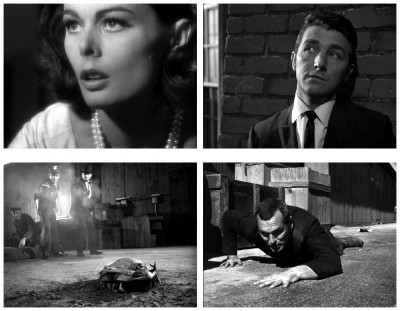 Thanks goes to Wikipedia for certain information, and a big thanks to David J. Schow and Jeffrey Frentzen, authors of the definitive tome The Outer Limits Official Companion (Ace SF 1986), one of the first best television episode guide books ever to be published. If you have any interest in the early formative days of American television, this volume should definitely be near the top of your list. At this point I’ll graciously invite you to please join me again next week when I have another opportunity to make your stomach turn and your flesh crawl with another lusting, slashing, ripping flesh-hungry, blood-mad massacre from the back side of…Horror News! Toodles!
Thanks goes to Wikipedia for certain information, and a big thanks to David J. Schow and Jeffrey Frentzen, authors of the definitive tome The Outer Limits Official Companion (Ace SF 1986), one of the first best television episode guide books ever to be published. If you have any interest in the early formative days of American television, this volume should definitely be near the top of your list. At this point I’ll graciously invite you to please join me again next week when I have another opportunity to make your stomach turn and your flesh crawl with another lusting, slashing, ripping flesh-hungry, blood-mad massacre from the back side of…Horror News! Toodles!
 Horror News | HNN Official Site | Horror Movies,Trailers, Reviews
Horror News | HNN Official Site | Horror Movies,Trailers, Reviews
